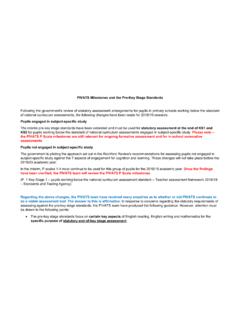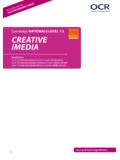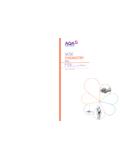Transcription of 2018 national curriculum assessment Key stage 2 - GOV.UK
1 2018 national curriculum assessmentKey stage 2 Teacher assessment exemplification: end of key stage 2 English writingWorking at greater depth within the expected standard: Frankie Page 2 of 35 Contents Guidance .. 3 Using exemplification materials .. 3 Using this writing exemplification .. 4 key stage 2 English writing teacher assessment framework .. 5 Frankie: Working at greater depth within the expected standard .. 7 Frankie: annotations .. 8 Piece A: Short story .. 8 Piece B: Description .. 10 Piece C: Explanation .. 12 Piece D: Newspaper report .. 15 Piece E: Diary .. 18 Piece F: Letter .. 21 Frankie: evidence check .. 23 Frankie: pupil scripts .. 24 Piece A: Short Story .. 24 Piece B: Description .. 25 Piece C: Explanation .. 27 Piece D: Newspaper report .. 29 Piece E: Diary .. 31 Piece F: Letter .. 34 Page 3 of 35 Guidance Using exemplification materials Exemplification materials provide examples of pupils work to support teachers in making judgements against the statutory teacher assessment frameworks at the end of the key stage .
2 If teachers are confident in their judgements, they do not need to refer to this document. Teachers should assess their pupils according to their school s own assessment policy, and use the statutory teacher assessment framework only to make a judgement at the end of the key stage . This judgement should be based on day-to-day evidence from the classroom which shows that a pupil has met the pupil can statements within the framework. Exemplification materials illustrate only how pupil can statements in the frameworks might be met. They do not dictate a particular method of teaching, or the evidence expected from the classroom, which will vary from school to school. Teachers should not produce evidence specifically for the purpose of local authority moderation. However, a sample of evidence from the pupil s classroom work must support how they have reached their judgements. Local authorities may find it useful to refer to exemplification materials to support external moderation visits.
3 The materials show what meeting the pupil can statements might look like. Moderators should not expect or require teachers to provide specific evidence similar to the examples in this document. This document is part of a suite of materials that exemplifies the national standards for key stage 1 English writing teacher assessment . The full suite is available on Page 4 of 35 Using this writing exemplification This document contains a collection of work from a real year 6 pupil, Frankie (whose name has been changed), that meets the requirements for pupil can statements within the statutory teacher assessment framework for working at greater depth . It shows teachers how they might judge whether a pupil has met the relevant standard. The collection consists of a sample of evidence (6 pieces) drawn from a wider range of the pupil s writing. Pieces have been selected specifically to exemplify the statements relevant to the greater depth within the expected standard at which Frankie is working.
4 Teachers should base their teacher assessment judgement on a broader range of evidence than that shown in this document. Evidence will come from day-to-day work in the classroom and should include work from different curriculum subjects, although a pupil s work in English alone may produce the range and depth of evidence required. Teachers can also use pupils answers to test questions as evidence to support their judgements. The evidence that teachers consider in English writing should be based on the pupil s independent work. The examples used in this document were produced independently, though the context for each piece explains where specific support was given (for example, certain vocabulary). Teachers should refer to STA s published teacher assessment guidance for further information on independent writing. Teachers can use their discretion to ensure that a particular weakness does not prevent an accurate judgement being made of the pupil s overall attainment in English writing.
5 A teacher should still assess a pupil against all of the pupil can statements within the standard at which they are judged, and a pupil s writing should meet all of the statements, as these represent the key elements of the national curriculum . However, a teacher s professional judgement takes precedence and this will vary according to each pupil. The frequency of evidence for pupil can statements may vary across individual pieces within a collection of a pupil s writing, depending on the nature of the statement and the writing. For example, some evidence for the statement use verb tenses consistently and correctly throughout their writing would be expected in almost all writing, whereas this would not always be the case for integrate dialogue in narratives to convey character and advance the action . This document illustrates how the statements in the framework containing qualifiers ( some , many , most ) may be applied to a particular collection of work.
6 Where qualifiers are used, they have consistent meaning: most indicates that the statement is generally met with only occasional errors; many indicates that the statement is met frequently but not yet consistently; and some indicates that the knowledge or skill is starting to be acquired and is demonstrated correctly on occasion, but is not yet consistent or frequent. Page 5 of 35 key stage 2 English writing teacher assessment framework Please also refer to the Teacher assessment frameworks at the end of key stage 2 on , as the guidance for using the frameworks has not been duplicated here. Working towards the expected standard The pupil can: write for a range of purposes use paragraphs to organise ideas in narratives, describe settings and characters in non-narrative writing, use simple devices to structure the writing and support the reader ( headings, sub-headings, bullet points) use capital letters, full stops, question marks, commas for lists and apostrophes for contraction mostly correctly spell correctly most words from the year 3 / year 4 spelling list, and some words from the year 5 / year 6 spelling list* write Working at the expected standard The pupil can: write effectively for a range of purposes and audiences, selecting language that shows good awareness of the reader ( the use of the first person in a diary.)
7 Direct address in instructions and persuasive writing) in narratives, describe settings, characters and atmosphere integrate dialogue in narratives to convey character and advance the action select vocabulary and grammatical structures that reflect what the writing requires, doing this mostly appropriately ( using contracted forms in dialogues in narrative; using passive verbs to affect how information is presented; using modal verbs to suggest degrees of possibility) use a range of devices to build cohesion ( conjunctions, adverbials of time and place, pronouns, synonyms) within and across paragraphs use verb tenses consistently and correctly throughout their writing use the range of punctuation taught at key stage 2 mostly correctly^ ( inverted commas and other punctuation to indicate direct speech) spell correctly most words from the year 5 / year 6 spelling list,* and use a dictionary to check the spelling of uncommon or more ambitious vocabulary maintain legibility in joined handwriting when writing at *These are detailed in the word lists within the spelling appendix to the national curriculum (English Appendix 1).
8 Teachers should refer to these to exemplify the words that pupils should be able to spell. ^This relates to punctuation taught in the national curriculum , which is detailed in the grammar and punctuation appendix to the national curriculum (English Appendix 2). Pupils are expected to be able to use the range of punctuation shown here in their writing, but this does not mean that every single punctuation mark must be evident. 1 At this standard, there is no specific requirement for a pupil s handwriting to be joined. 2 The national curriculum states that pupils should be taught to use the diagonal and horizontal strokes that are needed to join letters and understand which letters, when adjacent to one another, are best left unjoined . Page 6 of 35 Working at greater depth The pupil can: write effectively for a range of purposes and audiences, selecting the appropriate form and drawing independently on what they have read as models for their own writing ( literary language, characterisation, structure) distinguish between the language of speech and writing3 and choose the appropriate register exercise an assured and conscious control over levels of formality, particularly through manipulating grammar and vocabulary to achieve this use the range of punctuation taught at key stage 2 correctly ( semi-colons, dashes, colons, hyphens) and, when necessary, use such punctuation precisely to enhance meaning and avoid ambiguity.
9 ^ [There are no additional statements for spelling or handwriting] ^ This relates to punctuation taught in the national curriculum , which is detailed in the grammar and punctuation appendix to the national curriculum (English Appendix 2). Pupils are expected to be able to use the range of punctuation shown here in their writing, but this does not mean that every single punctuation mark must be evident. 3 Pupils should recognise that certain features of spoken language ( contracted verb forms, other grammatical informality, colloquial expressions, long coordinated sentences) are less likely in writing and be able to select alternative vocabulary and grammar. Page 7 of 35 Frankie: Working at greater depth within the expected standard Frankie is working at greater depth within the expected standard. This collection demonstrates evidence that Frankie is able to produce writing that meets all of the statements for working at greater depth within the expected standard.
10 Across the collection, adaptation for purpose and audience is enhanced by the writer s distinctive and independent voice. The range of writing includes pieces which explore, from different perspectives, the in-depth reading of a class narrative, while others derive from the writer s own personal interests. The writer is able to adopt different forms and levels of formality, often drawing on a single source, the formal newspaper report and the more informal diary, both inspired by the same short story; the different narrative perspectives in the 2 short descriptive paragraphs Opening The Fridge and Sneaking Downstairs ; and the 2 diverse pieces which draw on the writer s enthusiasm for, and personal experience of, dance. The writer demonstrates a clear understanding of the difference between the language of speech and writing through the conscious grammatical and vocabulary choices made. Minor edits have been made during the writing process to enhance description and improve clarity and accuracy.
















